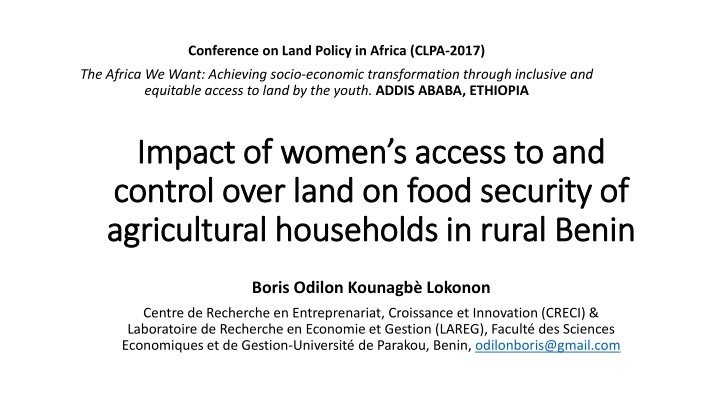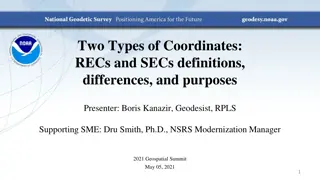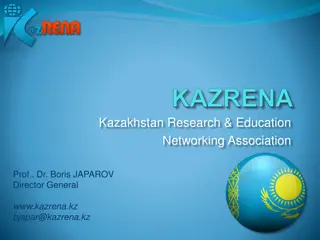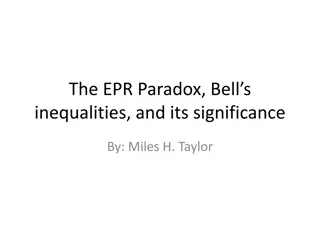
Impact of Women's Access to and Control over Land on Food Security in Rural Benin
Explore the impact of women's access to and control over land on food security in agricultural households in rural Benin. Discover how empowering women through land ownership can enhance productivity, welfare, and economic development.
Download Presentation

Please find below an Image/Link to download the presentation.
The content on the website is provided AS IS for your information and personal use only. It may not be sold, licensed, or shared on other websites without obtaining consent from the author. If you encounter any issues during the download, it is possible that the publisher has removed the file from their server.
You are allowed to download the files provided on this website for personal or commercial use, subject to the condition that they are used lawfully. All files are the property of their respective owners.
The content on the website is provided AS IS for your information and personal use only. It may not be sold, licensed, or shared on other websites without obtaining consent from the author.
E N D
Presentation Transcript
Conference on Land Policy in Africa (CLPA-2017) The Africa We Want: Achieving socio-economic transformation through inclusive and equitable access to land by the youth. ADDIS ABABA, ETHIOPIA Impact of women s access to and Impact of women s access to and control over land on food security of control over land on food security of agricultural households in rural Benin agricultural households in rural Benin Boris Odilon Kounagb Lokonon Centre de Recherche en Entreprenariat, Croissance et Innovation (CRECI) & Laboratoire de Recherche en Economie et Gestion (LAREG), Facult des Sciences Economiques et de Gestion-Universit de Parakou, Benin, odilonboris@gmail.com
Outline Outline Introduction Material and methods Results and discussion Conclusion and policy implications 2
Introduction (1/3) Introduction (1/3) Land constitutes an important capital (natural capital) for people that draw their livelihoods from agriculture. However, women are mostly left behind in terms of land rights in Sub-Saharan Africa (SSA). For instance, men dominate women in decision-making with regard to access to and control over land. Nevertheless, women play a key role in farming in SSA, and their access to and control over land influence positively food supply, farm household income and welfare including food security status. Access to and control over land is important in sustaining livelihoods, resource management and overall rural development (Wineman and Liverpool-Tasie, 2017; Alemu, 2015; Alston, 2014; Kongolo, 2012; Meinzen-Dick et al., 1997). 3
Introduction (2/3) Introduction (2/3) Nonetheless, empirical analyses are needed to test the validity of this assertion, to guide policy-makers on relevant policies to be implemented to improve food security status and in-fine to reduce poverty and inequality, especially in rural areas, heart of the agricultural production. Agricultural development is the engine to promote economic development and food security in Benin, a developing country located in West Africa. Benin is a coastal country with a population amounting to 10,008,749 inhabitants in 2013, according to the fourth census of the population. It should be noted that the total land size of the country is 114,763 square kilometers. Agriculture contributes about 35%% of the gross domestic product (GDP), and 70% of employment (R publique du B nin, 2014). 4
Introduction (3/3) Introduction (3/3) Women s land rights is found to promote development by empowering women, increasing productivity, and improving welfare (Allendorf, 2007). Indeed, women empowerment is considered as crucial in improving livelihoods and in boosting economic development. Land ownership constitutes a means of women empowerment by increasing women s security and affects their control over household decisions, including those related to food and nutrition (Agarwal, 1997; Haddad et al., 1997). It should be noted that women empowerment goes beyond the view of considering the household as a unitary entity which was introduced by Becker (1965) and assumes in modeling that household members seek to maximize utility on the basis of a set of common preferences represented by an aggregate utility function, and a common budget constraint (Agarwal, 1997). In this paper, we explore the impact of women s access to and control over land on per capita food expenditures and food security status. 5
Material and methods (1/6) Material and methods (1/6) Two types of models are estimated in this paper: the model of per capita food expenditures and that of food security status. Actually, food security is captured by per capita food expenditures and a variable related to food security status of the household. The model of per capita food expenditures is specified as follows: ??= ?0+ ?? where ?? is the per capita food expenditures of the household ?, ?? is the vector of regressors apart from the variable capturing women s access to and control over land, and ?? is the error term. The regressor of interest is ??which is relative to women s access to and control over land. Actually, we are interested in the magnitude and the sign of the parameter ?. ? + ???+ ?? (1) 6
Material and methods (2/6) Material and methods (2/6) Equation (1) can be estimated by the means of the ordinary least squares (OLS). However, the OLS estimates may be biased, because the variable capturing women s access to and control over land may be endogenous. Thus, the paper tests the endogeneity of women s access to and control over land through an IV approach of the model of per capita food expenditures (paying attention to the fact that the treatment is binary to avoid estimating a forbidden regression). Ethnicity of the household head is then used as instrument. Indeed, empowering women by giving them the right to control land may vary across ethnic groups. Other regressors of the model include the sex, the education level, and the age of the household head, household size, the number of persons that contribute to household income, livestock ownership, practice of irrigation, and use of improved seeds, herbicides, manure/organic fertilizers, chemical fertilizers and insecticides/fungicides, following the literature on the topic (e.g., Garret and Ruel, 1999). 7
Material and methods (3/6) Material and methods (3/6) The other model estimated in the paper is related to the determinants of food security status of the household. This model is specified as follows: ??= ?0+ ?? where ?? is the food security status of the household ?, ?? is the vector of regressors as described above, and ?? is the error term. Like in the case of per capita food expenditures, the interest is particularly by the side of the parameter ?. The same issue related to the likely endogeneity of women s access to and control over land also holds in equation (2). ? + ???+ ?? (2) 8
Material and methods (4/6) Material and methods (4/6) Thus, IV technique may be used. However, owing to the fact that the dependent variable the food security status of the household is categorical, the usual IV method is not applicable. Thus, one has to resort to the special regressor method using Lewbel (2012) approach (Baum, 2012). The same instrument ethnicity of the household head is used to implement the special regression. To estimate equation (2) with this technique, the dependent variable must be binary. Therefore, this paper uses a binary variable of food security status. Accordingly, the dependent variable in equation (2) is described as follows: ??= 1 ?? ? ? ???? ??? ?? ??? ?? ?????????? ?? ???????? ???? ???????? 0 ?? ? ? ???? ??? ?? ??? ?? ???? ?????? ?? ???? ??? ???? ???????? 9
Material and methods (5/6) Material and methods (5/6) Variables Per capita food expenditures Per capita food expenditures of the households Food security status Food security cluster of the household Description Unit Local currency (CFA F)a 0=Food secure/slightly food insecure and 1=Moderately food insecure/severely food insecure 1=Male and 0=Female 1=None 2=Primary 3=Secondary 4=University Number of persons 0=No and 1=Yes 0=No and 1=Yes 0=No and 1=Yes 0=No and 1=Yes 0=No and 1=Yes 0=No and 1=Yes 0=No and 1=Yes Years Number of persons Sex Education Sex of household head Education of household head Household size Irrigation Seeds Herbicides Organic Fertilizers Insecticides Livestock Age Active Number of individuals in the household Practice of irrigation Use of improved seeds Use of herbicides Use of manure/organic fertilizers Use chemical fertilizers Use of insecticides/fungicides Livestock ownership Age of household head Number of household members that contribute to household income Women own land Women s are owner of land 0=No and 1=Yes 10
Material and methods (6/6) Material and methods (6/6) The paper focusses on agricultural households from rural areas in Benin using data from the Survey of the Overall Analysis of Vulnerability and Food Security carried out in 2013 from February to March by the National Institute of Statistics and Economic Analysis (Institut National de la Statistique et de l Analyse Economique INSAE). The survey included 15,000 households from 750 villages/neighborhoods and is representative at the national, departmental and communal levels. After cleaning the dataset, it includes 4,371 usable observations (agricultural households from rural areas). In the survey women s access to and control over land is captured by ownership of women of the land they cultivate; thus a binary variable. However, this variable does not provide information on the quality of the land women own. 11
Results and discussion (1/3) Results and discussion (1/3) As aforementioned, the likely endogeneity of women s access to and control over land is taken into account in the two econometric regressions. However, the Durbin and Wu-Hausman tests indicate the non- acceptance of the hypothesis of endogeneity of women s access to and control over land. Owing to this finding, the paper considers women s access to and control over land as exogenous and estimate by OLS the model of per capita food expenditures. Nevertheless, the results of OLS and two stages least squares (2SLS) estimations are reported (Table 3). But, the preferred model is the OLS. 12
Results and discussion (per capita food expenditures) (2/3) Results and discussion (per capita food expenditures) (2/3) Variables 2SLS OLS Robust Std. Errors 171.28 205.99 Coef. Robust Std. Errors 962.94 266.3 Coef. Women own land Sex: Reference = Female Education: Reference =None Primary Secondary University Household size Irrigation Seeds Herbicides Organic Fertilizers Insecticides Livestock Age Active Constant Observations 2263.42** -1172.12*** 828.25*** -881.62*** 49.14 978.82*** 1719.07 -716.55*** 874.25*** 1594.14*** 1396.52*** 433.31** 131.20 -631.87*** 804.45*** 10.77** -70.68 8476.73*** 165.88 280.82 1866.31 35.5 256.28 382.57 242.21 211.88 151.99 233.31 144.12 4.95 72.38 366.68 91.4 162.21 276.45 1864.73 35.12 232.02 331.22 240.55 201.02 149.72 200.00 142.13 4.88 64.31 350.77 1064.38*** 1666.29 -725.59*** 994.42*** 1958.74*** 1484.42*** 533.76*** 81.65 -829.18*** 782.40*** 12.05** -2.74 8599.64*** 4368 4371 13
Results and discussion (food security status) (3/3) Results and discussion (food security status) (3/3) Variables Special regression Std. Errors 0.14 Logistic Robust Std. Errors 0.06 0.17 Coef. -0.22 Marginal effects -0.01 0.03 Odds Ratio 0.48*** 1.40*** Women own land Sex: Reference = Female Education: Reference =None Primary Secondary University Household size Irrigation Seeds Herbicides Organic Fertilizers Insecticides Livestock Age Active Constant Observations 0.13*** 0.12*** 0.11 0.02*** 0.09*** 0.02 0.08** 0.05* -0.03 -0.01 -0.03 -0.003*** 0.03** -0.11** 0.03 0.04 0.2 0.004 0.03 0.05 0.04 0.03 0.02 0.04 0.02 0.001 0.01 0.05 4151 0.005 0.004 0.004 0.001 0.003 0.001 0.003 0.002 -0.001 -0.0003 -0.001 -0.0001 0.001 -0.004 0.67*** 0.35*** 0.45 0.97* 1.26* 1.17 0.76* 0.91 1.49*** 0.96 1.43*** 1.00 0.77*** 0.30*** 0.08 0.08 0.47 0.02 0.16 0.19 0.12 0.11 0.14 0.12 0.13 0.003 0.05 0.06 4369 14
Conclusion and policy implications Conclusion and policy implications This paper examined the impact of women s access to and control over land on per capita food expenditures and food security status in rural Benin. Women have access to and control over land in 21.19% of the agricultural households included in the sample. Per capita food expenditures and food security status of the households appear to be positively related to women s access to and control over land, supporting the importance of women empowerment with regards to land rights in improving food consumption and food security. Within a period of 30 days, farm households with women having access to and control over land have on average per capita food expenditures higher of 828.25 CFA F compared with their counterparts. The findings suggest that to improve food security the Beninese government should enact policies that facilitate women s access to and control over land and their effective access to resources such as labor, and fertilizers (going beyond assuming a unitary model of the household). The indicator of women s access to and control over land used does not account for the quality of land, therefore future research should account for that. 15
Thank you Thank you 16






















